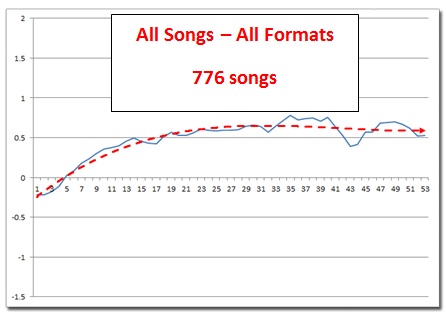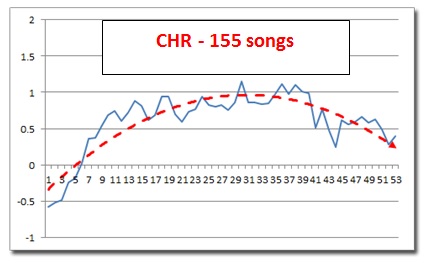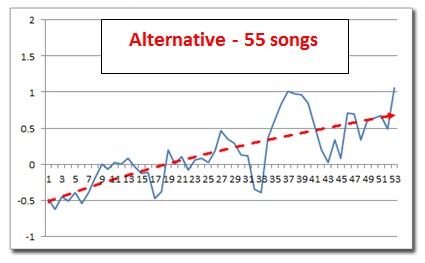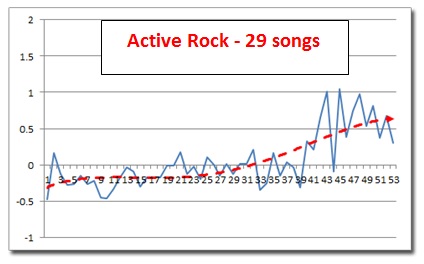Last month, I had the pleasure of presenting Techsurvey10 to an enthusiastic crowd at the Worldwide Radio Summit in Los Angeles. One of the best features of this massive study of more than 37,000 respondents is the format distinctions that help programmers better understand their discreet audiences.
 Later in the afternoon, RCS/Media Monitor CEO Philippe Generali presented an important research study that showed the trajectory of new songs by format, using his company’s M Score platform.
Later in the afternoon, RCS/Media Monitor CEO Philippe Generali presented an important research study that showed the trajectory of new songs by format, using his company’s M Score platform.
If you’re not familiar with M Score, it is a very different music measurement that combines Mediabase airplay data with actual listening behavior from Nielsen Audio PPM markets. Like any form of research, M Score has limitations – including the fact that we don’t know why consumers change stations when they do – but it is a very unique way to better understand switching behavior (or the lack of it).
Yesterday’s guest post from Bill Jacobs talked about new Spotify song-skipping data that sheds more light on consumer behavior, and the fickle nature of the way that most of us move through music. These new analytics add to the time-honored debate of what truly makes a hit.
And that’s why M Score data is an important component in that conversation about music consumption and acceptance. Philippe’s presentation in L.A. was revealing, and strongly suggested that when it comes to success with music on the radio, there are startling differences by format.
I’m not going to show them all in this space, Philippe’s contact info is below, and I know he’d be happy to share this information with you. But by highlighting a few formats, you can see that when it comes to new music, it is not a level playing field.
So far all songs in all formats in 2013, Media Monitors had a database of 776 songs to work with. On the graph below, you can see the curve of a new song across the number of weeks of airplay (seen at the bottom):
Here’s Top 40, where new songs tend to establish very quickly, reach higher M Score numbers than the average song and have a tendency to stay in a very positive range for more than 40 weeks. (You will be hearing “Happy” for some time to come.)
I was somewhat surprised by Country, a format where everyone gushes about new music at every opportunity. These numbers are positive and obviously healthy. On average, it takes just a few weeks for currents to get established. And the great Country songs can have durability – remaining viable for a year. But as you can see in comparison to a format like CHR, the peak scores for Country tend to be lower. And that seems a bit unusual for an audience with so much passion for the music.
For those who work in various forms of contemporary Rock and Alternative radio, however, the curve to success for new music is loaded with hurdles, speed bumps, and patience.
Here’s the trajectory for the average Alternative current. And here you can begin to see the challenge – songs tend to start out “under water,” and don’t typically achieve net positive scores for weeks. The good news, of course, is that there is staying power, but that often creates a dilemma for Alternative PDs when these songs inevitably cross over to CHR. An audience bent on new music discovery may not enjoy hearing the same “current” song for six months, especially when it’s being pounded by the Top 40 and perhaps even Hot AC stations in town.
And then there’s the slowest curve of them all – Active Rock. I’ll let this M Score chart speak for itself. (Cue the gasps.)
In a simple chart, this M Score bucket of cold water very much describes the struggle that many Active Rock stations have undergone with breaking new music for well more than a decade. The average song for this format percolates (that’s the nicest way I can say it) for months before every truly getting going, forcing stations to keep the faith in music that may or may not ever take root and produce dividends. Now most programmers would say that’s the bet that everyone makes when it comes to new music. But the reality is that there are more barriers to making hits in Active Rock – and more meter punishment for a bad risk – than in any other format that relies on new music.
And this condition has effects that go well beyond the A’s and B’s.
Here’s the Techsurvey10 pyramid for Active/Mainstream Rock where fans of the format were asked to indicate the main reasons why they listen to the radio. A look at the bottom of the pyramid reveals an equal amount of attraction for personalities and music. And in fact, this is the only music format where the strength of DJs matches the appeal of the music:
The M Score data is a reminder that the risk/reward music relationship differs greatly by format. And it raises the question about how Active Rock (and even Alternative)approach breaking music. You could make the case they should be asking for and receiving support from the labels and the artists themselves. An Active Rock add is the worst bet of them all, so investment by all parties – the station, the label, and the artists – might all be necessary in order to help make hits.
Music discovery is a stated desire for fans of both formats (especially Alternative). But there’s often a price to be paid. These M Score data suggest that unlike a Pandora or a Spotify, most radio stations are putting chips out on the table by playing many of the new releases to begin with. That truth might have relevance in the ongoing debate over music royalty payments, and who should be writing the checks. In Rock Radio, you could make the case that stations have been paying the price for playing much of the new music that’s been released during the past decade – or more.
There’s a hidden cost that many stations in PPM markets need to be prepared to pay every week as the learning curve of new music grows.
Especially rock stations.
Here is Philippe Generali’s email address to contact him for more information – [email protected].
- What To Do If Your Radio Station Goes Through A Midlife Crisis - April 25, 2025
- A 2020 Lesson?It Could All Be Gone In A Flash - April 24, 2025
- How AI Can Give Radio Personalities More…PERSONALITY - April 23, 2025










Lemme make sure I have this straight: We compare heavily currents-based formats like Pop and Country against Rock to lament the “risked chips” involved in playing new music on Alternative and Active, and the first solution that comes to mind is brokering out the “New Music Discovery”? That’s a terrible idea.
While we certainly must respect the data and what it tells us, let’s not kid ourselves. “In Rock Radio, you could make the case that stations have been paying the price for playing much of the new music that’s been released during the past decade – or more.” This is 100% true for Active. The music that’s been chosen to play has been terrible. Niche sonic palettes and forgettable posturing, lacking personality, melody or hooks.
Its one thing to be taste-agnostic, another to deny just how bad a job has been done stewarding the format and finding hits. If we can’t look in the mirror and admit this, all the M Score Data and “support” from labels and artists is not going to change a thing.
Respectfully: think-pieces like this have helped paint rock programmers into the corner they find themselves in today: unable to play much – let alone break – any new music. Alternative has successfully managed to broaden its sound (and listener coalition) as the music has gotten more diverse, why is Active is turning to the same artists and same sound when it looks to fill a coveted new music slot? Its not like there isn’t enough good music, it just takes some stones to find and champion it.
I’m curious what constitutes “bad risk” in your view? And what makes the meter punishment it invites more intense? I don’t see how we can talk about tune-out without addressing the failure to fulfill the format and audience’s “stated desire” for music discovery in a meaningful way.
Jenni, thanks so much for the head-on response. I think it’s important to get a label POV on this, however much I’m on the other side of the argument. It is a chicken/egg thing at its heart. What responsibility do the labels and bands have in supporting their craft, and how much is radio willing to take risks to keep its formats fresh?
I think the reason why Rock PDs are in a corner is the failed attempts – and there have been too many to count – where airplay support was given to songs and projects – over time – with little to show for these efforts. Your point that Rock radio programmers (and consultants) may have taken too narrow an approach in defining new music is well taken and worthy of discussion. I will tell you that after sitting through every type of research, from focus groups to music tests to perceptual studies, it is difficult to find new music that truly resonates and excites today’s audiences.
That’s my view of it from my trench. I would welcome anyone in and around the Rock radio community – from labels to bands to radio – to chime in. This is what this blog is about and I appreciate you airing it out, Jenni. And Go Green!
PS Fred almost forgot: SPARTY ON! MSU ’92 WDBM